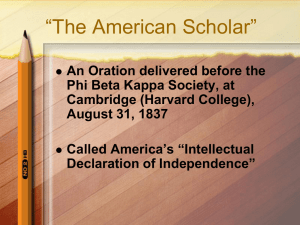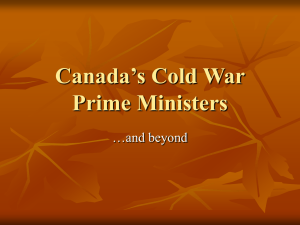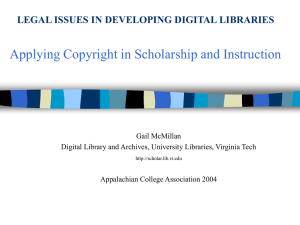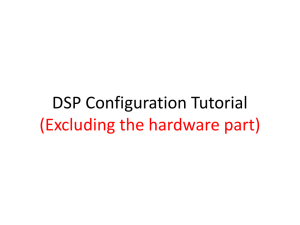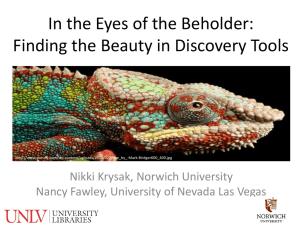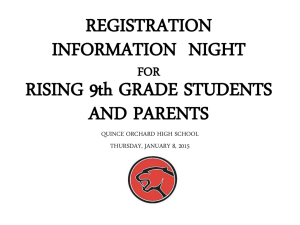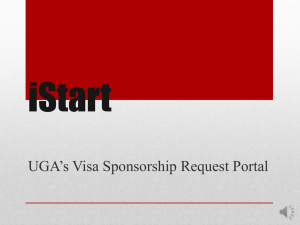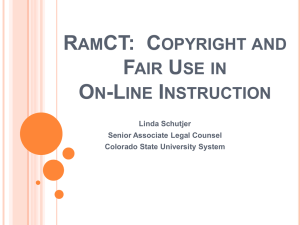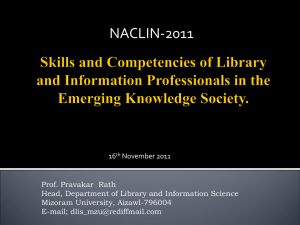Copyright in Scholarship and Instruction & an Open Access Primer
advertisement
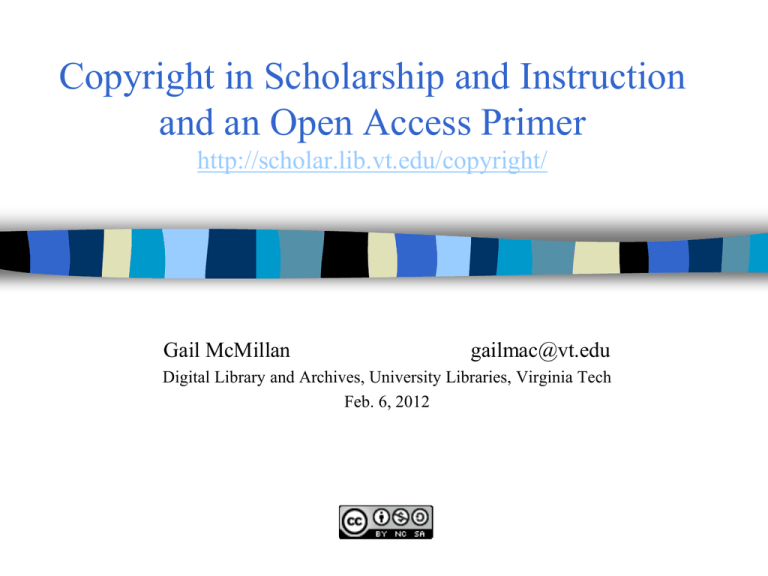
Copyright in Scholarship and Instruction and an Open Access Primer http://scholar.lib.vt.edu/copyright/ Gail McMillan gailmac@vt.edu Digital Library and Archives, University Libraries, Virginia Tech Feb. 6, 2012 U.S. Constitution Article I Section 8 Clause 8 [The Congress shall have power] "To promote the progress of science and useful arts, by securing for limited times to authors and inventors the exclusive right to their respective writings and discoveries." Copyright Law: U.S. Code, Title 17 Section 102: Original authorship stabilized – when fixed in a tangible medium of expression Section 106: Exclusive rights of creators Limitations to exclusive rights Section 107: Fair use Section 108: Library services Section 110: Instruction--TEACH Act http://scholar.lib.vt.edu/copyright/ Who owns the copyright? Creators of original works Life + 70 years Employers: works for hire 95 years from publications, or 120 years from creation Creators' assignees As copyright holder, you control Reproduction Modification Distribution Public performance Public display EXCEPT… Permission or license to use a copyrighted work is NOT required if Work is a fact or an idea – Phone numbers, earth is round Public domain – Does not mean the Internet/worldwide web – Intellectual property not owned or controlled by anyone • US government documents • It’s very old: http://www.unc.edu/~unclng/public-d.htm Fair use TEACH Act Fair Use Myth It's OK--it's for educational purposes. Before using someone else's work without permission, weigh ALL 4 FACTORS VT Fair Use Analyzer Fair Use Checklist 1. Purpose and character of use 2. Nature of the work 3. Amount, substantiality 4. Effect 1. Purpose and character of use Commercial or educational use For profit or not Degree of transformation; value added For criticism, commentary, news reporting, teaching, scholarship, research FAIR USE 1 of 4 2. Nature of the copyrighted work Worthy of (extensive) protection? Character of the work? – fact (information) or fiction (imaginative) • Published facts weigh in favor of fair use • Unpublished original expressions weigh in favor of seeking permission FAIR USE 2 of 4 3. Amount and substantiality Use only what is necessary Quantity in relation to whole work Quality in relation to whole work FAIR USE 3 of 4 4. Effect Harm to potential market or value of a work after a portion has been used separately from the whole FAIR USE 4 of 4 Fair use: weigh each factor VT Fair Use Analyzer Did the scales tip in favor of fair use? If not – Modify your use – Use library services: Title 17 U.S.C. Sec. 108 Ereserve Why not use Scholar? – Ask for permission After you’ve checked Sherpa RoMEO – publisher copyright & self-archiving policies – http://www.sherpa.ac.uk/romeo/ Copyright permission services Copyright Clearance Center – http://copyright.com Association of American Publishers – http:// www.publishers.org You asked but they never responded. You don’t have permission. Orphan Works Good faith, diligent, unsuccessful search US Copyright Office report (2006-01) http://www.copyright.gov/orphan/orphanreport.pdf The “Orphan Works” Problem (2008-03-13) – Statement of Marybeth Peters, Register of Copyrights, to House Subcommittee on Courts, the Internet, and Intellectual Property http://www.copyright.gov/docs/regstat031308.html Legislation, amendments, no vote. Assume it’s copyrighted Copyright re Libraries: Sect. 108 Ground Rules Preservation copying Photocopy Services: Copies for private study ILL: copies for InterLibrary Loan – No commercial purpose – Open to outsiders – Notice on copies http://www.ill.vt.edu/Copyrightinformation.htm Reserve Services: copies for students in a course http://www.lib.vt.edu/services/circ-reserve/copyright.html Copyright for Instruction USC Title 17 Section 110 – Limitations of certain performances and displays – Face-to-face classroom settings Broadened by TEACH Act (Nov. 2, 2002) – Technology Education And Copyright Harmonization – Must have an institutional copyright policy TEACH Act Fair use standards in online education environment Modified existing copyright law for – – – – – – Accredited nonprofit educational institutions Mediated instruction Integral part of class session Limited to enrolled students Accurately informed about copyright compliance Reasonably prevent Retention beyond course Unauthorized further dissemination TEACH Act: Works allowed DISTANCE LEARNING CLASS IS THE SAME AS IN THE CLASSROOM Show entire nondramatic literary works – News, poetry, speech – Show entire nondramatic musical works Everything else in reasonable and limited portions – Plays, movies, operas, TV shows, choreography TEACH Act--You must not use Works marketed primarily for distance education Unlawfully made or acquired copies Materials meant for additional study outside of class – EReserve, Reserve, Scholar (i.e., CMS) TEACH Act--You must Transmit as an integral part of class session – Regular part of systematic, mediated instruction Use copyrighted materials only when directly related to the lesson Limit access to students enrolled in the course Have an institutional copyright policy & inform students about it Block further dissemination Copyright Resources from VT DLA Copyright Homepage http://scholar.lib.vt.edu/copyright/ Library Copyright Policies http://scholar.lib.vt.edu/copyright/cpolicies.html Fair Use http://scholar.lib.vt.edu/copyright/doesntsa.html#fairuse Copyright and ETDs http://scholar.lib.vt.edu/copyright/cprtetd.html Request Permission: Sample letter http://etd.vt.edu/howto/permission.html Publishers copyright & self archiving policies http://www.sherpa.ac.uk/romeo/ Copyright Resources Copyright Advisory Office, Columbia http://copyright.columbia.edu/copyright/ Crash Course in Copyright (UTAustin) http://www.utsystem.edu/OGC/IntellectualProperty/cprtindx.htm Library of Congress, Copyright Office http://lcweb.loc.gov/copyright/ Legal Information Institute (Cornell) http://www4.law.cornell.edu/uscode/17/ Stanford University Libraries http://fairuse.stanford.edu WIPO Study on Copyright Limitations and Exceptions for Libraries and Archives (Crews, 2008-2-26) http://www.wipo.int/meetings/en/doc_details.jsp?doc_id=109192 TEACH Act Toolkit (NC State) http://www.provost.ncsu.edu/copyright/toolkit/ Open Access: A Primer What is it, really? Gratis, libre, green, gold: decode the jargon Intellectual Property @ VT Peter Suber, Joy Kirchner, VT Provost’s Office Charles Eckman, Patricia Hudson, Dan Morgan: http://connect.ala.org/node/128235 Open access is using the Internet to make research literature publicly available “There are better ways to pay the bills than by charging readers and creating access barriers.” Why remove access barriers? Accelerate research Enrich education Share the learning of the rich with the poor and the poor with the rich Make this literature as useful as it can be Lay the foundation for uniting humanity in a common intellectual conversation and quest for knowledge Legal basis of Open Access Consent of the copyright holder for newer literature Expiration of copyright for older literature What’s gratis and libre OA? Gratis OA Libre OA No barriers have been removed Does not allow more than fair use Author has removed permissions barriers in advance Both gratis and libre remove financial barriers. OA authors allow Internet users Read Download Copy Distribute Print Search Link Index Pass text as data to software Any other lawful purpose Copyright still gives authors control over the integrity of their work and the right to be properly acknowledged and cited. Roads to Open Access Retain enough rights Authors have copyrights until they transfer them. Journal publishers Authors share their rights by permitting nonexclusive use of their copyrighted works. – – – – Director of OA Journals www.doaj.org NIH PubMed Central deposit University/library repository: VTechWorks VT Policy 13000 VT Faculty Handbook, IP Policy 13000 Traditional results of academic scholarship, i.e. textbooks, literary works, artistic creations, artifacts Contribute to the university’s benefit by their creation and continued use by the university in teaching, further development, enhancements of the university’s academic stature Presumption of ownership is to the author(s) VT Faculty Handbook Intellectual Property Policy 13000 Presumption of ownership is to the author(s) University rights limited to free/no cost use in perpetuity – – – – Teaching Research Extension Etc. What does green and gold OA mean? Gold OA = peer-review + publicly available – Subsidized by host (university, society) – Charge fees to accept articles • Paid by authors, employers, grants • VT Libraries/Office of Research may provide resources Green OA = self archiving, IR – DLA, VTechWorks – Both may restrict access for a limited duration when required, but the goal is to provide public access to this information, not just access to the current university community. OA charges Hudson/Oxford/ALA Subsidized Faculty Benefited UC Berkeley Simon Fraser Ranks of Benefiting Faculty UC Berkeley Simon Fraser Charles Eckman Reported at ALA Midwinter 2012 Faculty will publish OA when insulated from publication charges by funds from whatever source – Researchers will use extramural funds – University OA fund will be tapped <1% of a library’s materials budget makes a big difference Experimentation is – Practiced by the publishing community – Valued by campus community – Vital for libraries Kircherner’s Economics of Quality

